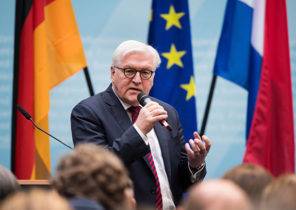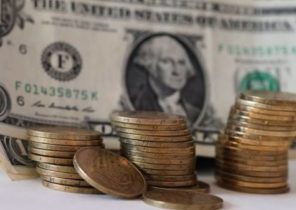
What to do to transition to sustainable growth of Ukrainian economy? You first need to correctly classify the situation in the country. Many economic downturns over relatively quickly, and relatively painlessly too often it is because to confront them, there is a rather simple technocratic answer from the Toolbox of Central banks — lower interest rates. Then it often happens that the economy is shifting to growth.
The cycle of gradual reduction in interest rates, the NBU began on 27 August 2015. Over the past nearly two years, it decreased by 17.5 basis points — from 30% to 12.5%. How much this influenced the output of Ukraine’s economy out of recession? I think that significant contribution was made but also to overestimate it. Can we continue to reduce the rate of NBU? If we are to achieve the planned targets on inflation, the potential for reducing the rate of the national Bank now and in the near term is very limited.
What to do to transition to sustainable growth of Ukrainian economy? You first need to correctly classify the situation in the economy, and on this basis, to determine what to do and what not to do.
In those conditions that exist now in Ukraine — Economics for a long time working below its capacity — the total amount of goods and services that consumers are willing to buy less than the total amount of goods and services that producers are willing, respectively, to produce and provide. Therefore, we are limiting the growth of non-productive capacity. The main limitation of the economic growth happening in Ukraine from the weak demand.
In application to the current situation in the economy of our country want to pay attention to two paradoxes, which he wrote the Nobel laureate in Economics Paul Krugman, in which logical at first glance, the action may have unexpected negative consequences. Referring to the paradox of thrift and the paradox of flexibility.
The paradox of thrift is a situation when efforts to save more lead to the fact that as a result, investments are reduced. According to the theory, if you look at the economy as a system, then the saving is equivalent to investment. Imagine the situation that a certain group, in particular, the household becomes more future-oriented (in connection with the upcoming uncertainty of the economic situation, unfortunately). Therefore, it is more willing to give up consumption today in favor of saving for the future. This is the usual instinctive reaction of people who do not believe that in the future will have the income at the current level. Many Ukrainians who survived the crises of 1998-1999, 2008-2009 and 2014-2015 objectively exposed. In some cases, would expect that the desire to save for the future will lead to higher investment costs, resulting in Ukraine’s economy really would get more reserves for your future: would build more new businesses to have upgraded existing plants to increase productivity and production of modern products, that is, in order to which we should aspire. Put simply, it works through interest rates — an increase in savings that go into investment, leads to lower interest rates (increased supply means reduced price) that reduce the cost of credit for companies. That is, the cost of borrowing for companies that are planning upgrades and expansion of production falls. The result is increased investment. But in the current situation in Ukraine, interest rates, as I have shown above, have limited downside potential due to possible inflation risks. That’s why the process of transformation of savings into investments and start to work.
That’s the paradox — according to Krugman, there are times when trying to save for the future leads to a General reduction of investment in the economy. If you want, you can argue with Krugman about what he built a complex design. But, anyway, if not savings, then investment in them is given the scenario that characterizes the folding we have a situation not increase.
Now the paradox of flexibility. The traditional view suggests that to increase sales of the product have to lower its price. When the surplus supply of labour that is observed in Ukraine, to reduce the cost and price of products management companies may seem a good move to lower wages (by the way, some economic historians are of the opinion that the Great depression would have ended sooner if the US President Roosevelt allowed trade unions to oppose the pay cut).
But sometimes it’s much more complicated. Indeed, workers can keep their jobs by agreeing to a pay cut. This can be explained to some extent by rational reasons — in the case of reducing the salaries of the employees of that particular company, its products become cheaper than those of competitors, thus increasing sales of products of this enterprise, it is gaining more market share, and its workers have prospects to keep their jobs. However, this decline in wages may acquire a competitive nature and that no one will get a comparative advantage. Positive impact on employment is through interest rates, and it works just through policy of the Central Bank — reducing wages leads to lower inflation, which in turn induces the Central Bank to lower the interest rate, which results from a certain moment increasing the demand, hence, increase employment. However, in our present conditions, further reduction of the NBU discount rate is the risk that inflation will start to rise earlier than increased demand, that is, to lower the rate would be risky. That’s why in Ukraine and there is the chain on which the reduction in wages could increase employment.
Moreover, the decline in wages is likely to lead to higher unemployment. You ask — why? This explained a great economist Irving Fisher. The fact that many citizens in the period of stable state of the economy have various debts (in our case, for example, mortgage, car or consumer loans). But, if the economy faces a crisis, people are forced to reduce spending in order to accumulate funds for the debt repayment that occurred in our country. Creditors to whom the debts will be repaid, given the uncertainty about the sustainable growth of the economy, are unlikely to have incentives to once again put the money into circulation. Eventually, aggregate demand is reduced. That is not conducive to a confident transition to the growth phase, hence the enterprise can start downsizing. It turns out that a flexible labour market in which the threat of unemployment wages are not growing, or even declining, in our conditions, no impulse to economic growth will not, nor improve the employment will not contribute. By the way, this is another argument in favor of carried out on the initiative of the government increase the minimum wage for which the Cabinet were subjected to unfounded criticism.
Measures which can give effect in normal cyclical crises, may not yield result when you exit Ukraine’s economy from the deep recession, in which she found herself in 2014-2015. It turns out that the economic player who decides to spend less, not always contributes to the output of the economy out of recession. A participant of economic processes, which increases their spending may help the economy in both the short and long term. But, most importantly, have at least one player who needs to take all this into account. Analysis of examples of exits from a deep recession indicates the validity of fiscal stimulus — increased government spending or transfers, or, alternatively, a tax cut that will boost spending in the private sector. By the way, the national debt in this situation doesn’t crowd out private investment, as it can lead to higher private investment — because a stronger economy gives businesses more reasons to expand production.
The youngest Professor in history at Harvard University, former Director of the National economic Council Lawrence summers in 2012, wrote that during recessions fiscal expansion conducted in a reasonable range, useful for fiscal health in the long run, whereas excessive austerity is harmful.
In the period when the economy was recently in a serious recession, and now we must transition to a stable and rapid growth, the rules change — tested for the usual time of crisis a set of actions rather contribute to the preservation of a recession than out of it. So we, as one of the methods, you need to pay attention to the point and selective stimulation of demand — consumption and investment. With a maximum emphasis on stimulating demand for products produced in Ukraine.






